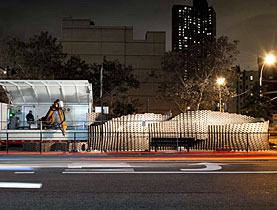
Swiss robot creates art one brick at a time

For close to four weeks in autumn a robot shipped in from Switzerland was busy laying bricks for a sculpture built deep in the heart of New York City's Chinatown.
Swiss architects Fabio Gramazio and Matthias Kohler are behind the project, which marks the first time a robot has been used to build an installation on site.
The robot, nicknamed Rob, worked 14-hour-days in full view of the public to construct the sculpture – a brick wall which forms an infinite loop – arranging and gluing more than 7,000 bricks, each in a unique position.
“We were interested in this because it’s the first time an industrial robot is being used for architectural purposes,” Cesar Cotta, a producer at the non-profit Storefront for Art and Architecture, told swissinfo.
Storefront procured the architects from the research unit for Architecture and Digital Fabrication at the Federal Institute of Technology Zurich (ETHZ), along with Rob, to build the 22-metre-long installation – called Pike Loop – that weaves along a pedestrian island.
From industry to architecture
Gramazio and Kohler developed the robot building process through their research into how industrial robots used to assemble automobiles and perform other high-precision tasks can be used in architecture.
“Each of the bricks in the wall can be rotated in a slightly different way because the computer can calculate it and the robot can handle almost an infinite number of small details,” Kohler told swissinfo.
Although it is theoretically possible to build the same wall by hand, it would be unrealistic due to the amount of work required to measure the location of each and every brick.
Architects and students from a number of American universities, including Harvard, Columbia and Carnegie Mellon, visited the exhibition to better understand the new techniques.
“The Gramazio & Kohler work is a wonderful spatial, sculptural, robotic experiment. Process, form, material and structure are integrated, with a feeling of economy and joy,” New York-based architect Steven Holl told swissinfo.
Robot revolution?
While the research is still in its early stages Kohler says he thinks employing robots in the construction of buildings will soon become a reality.
Next year Gramazio & Kohler expect to use Rob to work on an apartment building they are planning in Zurich. “We want to employ the robot in building the façade and possibly even for the structure of the building,” Kohler said.
But Kohler says his ultimate goal is to better understand what kind of new spaces can evolve with the use of new technologies.
“Just as there were shifts in the expression of architecture each time new materials were introduced, such float glass, steel or reinforced concrete, you will see shifts with the use of computers and robotics,” Kohler said.
The Pike Loop installation will be exhibited until the end of the year.
Karin Kamp in New York, swissinfo.ch
The robot – Rob – was manufactured in Germany; the Swiss architects modified it to suit their needs.
Gramazio & Kohler used Rob to build a 400-square-metre façade for a vineyard in Fläsch, Switzerland.
Their work with Rob was shown in an award-winning installation at the 2008 architectural biennial in Venice.

In compliance with the JTI standards
More: SWI swissinfo.ch certified by the Journalism Trust Initiative















![The four-metre-long painting "Sonntag der Bergbauern" [Sunday of the Mountain Farmers, 1923-24/26] had to be removed by a crane from the German Chancellery in Berlin for the exhibition in Bern.](https://www.swissinfo.ch/content/wp-content/uploads/sites/13/2025/12/01_Pressebild_KirchnerxKirchner.jpg?ver=a45b19f3)













You can find an overview of ongoing debates with our journalists here . Please join us!
If you want to start a conversation about a topic raised in this article or want to report factual errors, email us at english@swissinfo.ch.